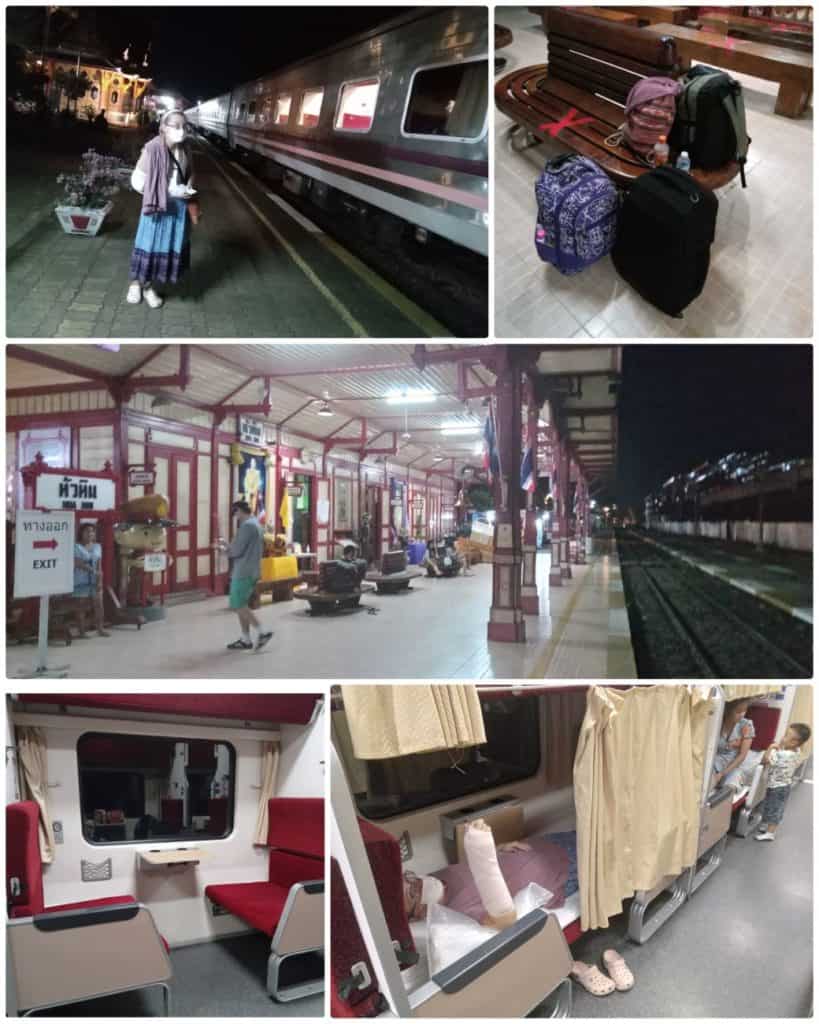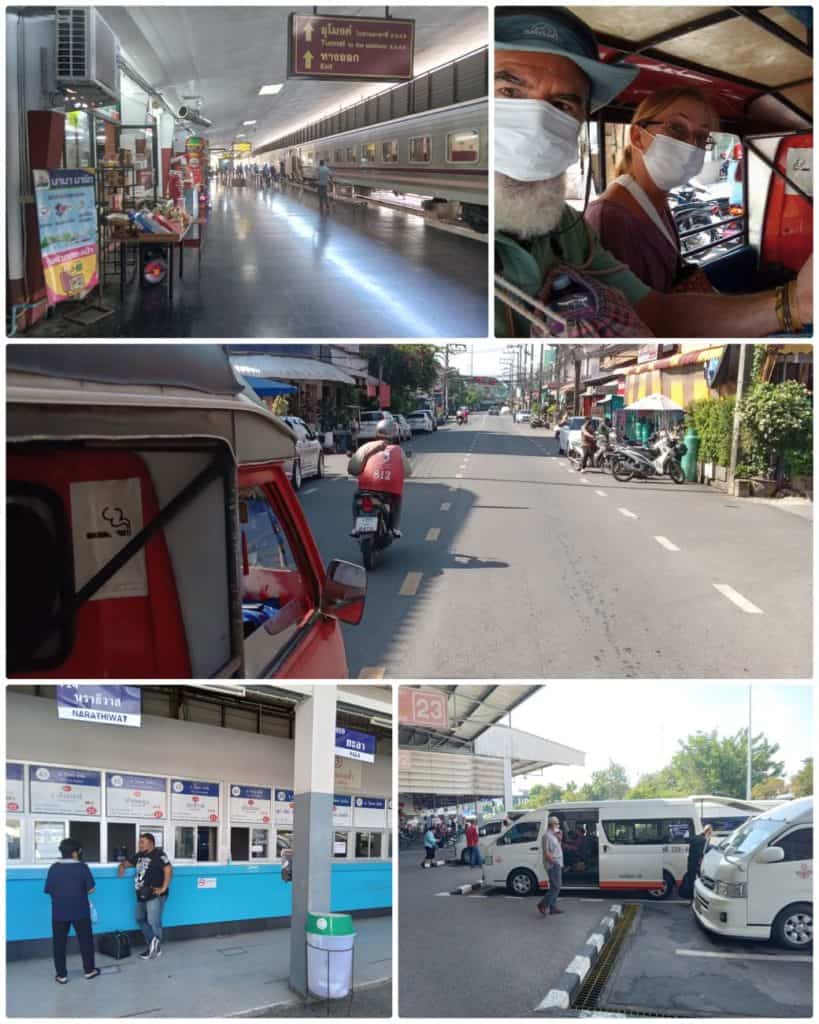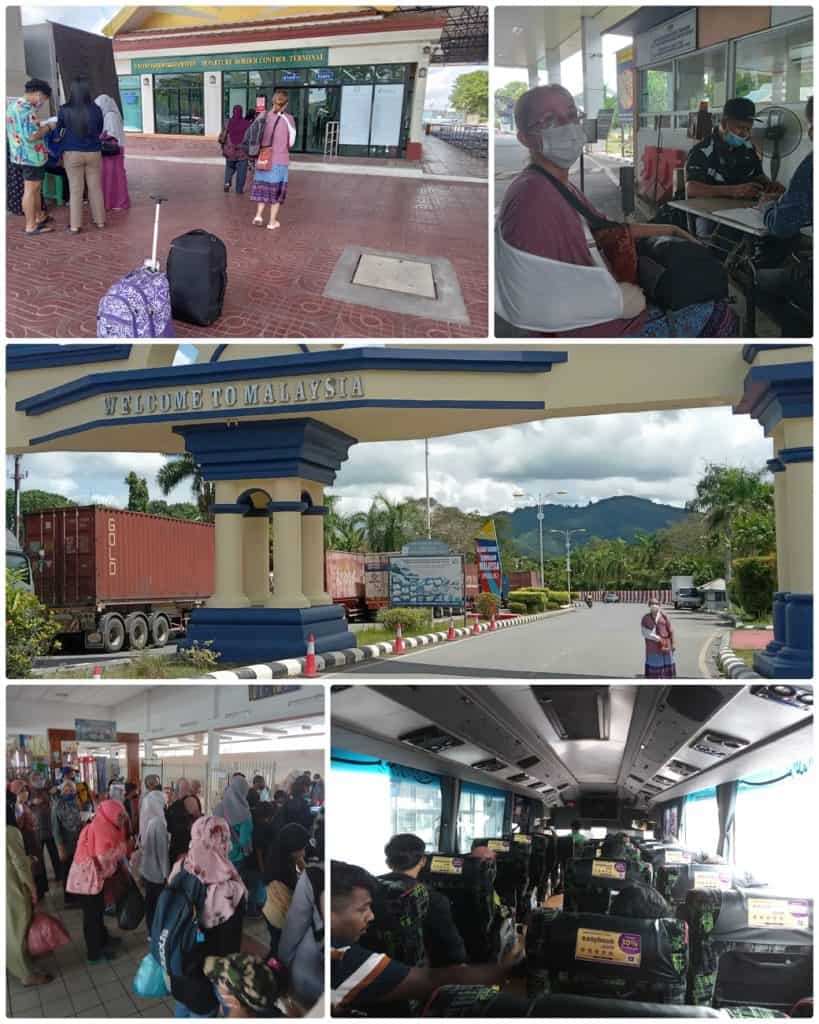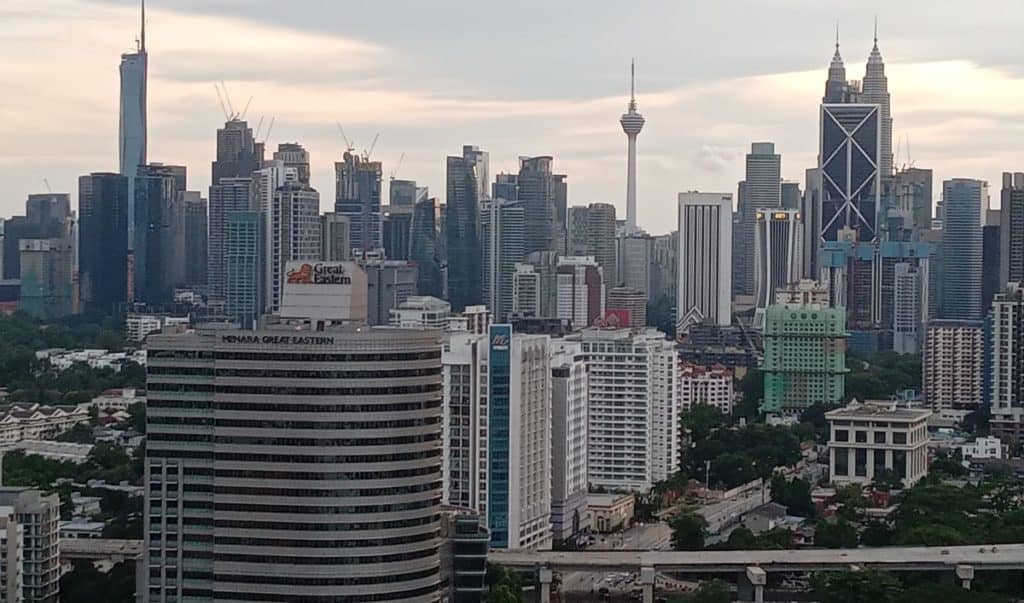Last Updated on October 25, 2024 by Ellen
We made it into Malaysia. We’re relaxing in Kuala Lumpur after the adventure. This is how you can enter Malaysia from Thailand at a land border in the ‘new normal.’
We made the crossing within weeks of Malaysia opening to international travelers in the COVID era. And we did it all with Ellen’s broken right wrist in a sling. Always an adventure!
It really began weeks ago, when Air Asia cancelled our cheap, direct flight. We decided a train ride and land border crossing might be fun. COVID testing and insurance no longer required.
Here’s the play-by-play of our overland travel across the Thailand-Malaysia border, with 2022 prices included.

Enter Malaysia from Thailand at Padang Besar
Hua Hin overnight train to Hat Yai
We left our month-long Airbnb studio in Hua Hin, Thailand (3 hours south of Bangkok) at 6 p.m.
We took a Grab (Asia’s Uber) to the Hua Hin train station for a scheduled departure at 7:05 p.m.
The overnight express sleeper to Hat Yai was 90 minutes late. Hat Yai is a large Thai city about 35 miles from the Malaysia border crossing at Padang Besar.
Normally, Thai railway trains run right to the border. But ever since the COVID lockdowns, Hat Yai is the end of the line. Apparently, now there are not enough international travelers to make the full train run economically viable.
We bought advance train tickets for $30 each. The clerk told us other ground transport in Hat Yai could get us to the border in order to enter Malaysia from Thailand. The same transit runs the other direction too.

Thailand train experience
Face masks and distancing – still required on the half-empty train. No dining car or food was available. A hyper Thai boy raced up and down the aisle bemused at us old foreigners.
We could see very little from the windows to begin the 12-hour journey through the night time jungles. Soon, we settled into our clean, modern, air-conditioned sleeper berths. Once every couple hours, the train made a stop as we slept.
At 6:30 a.m. I was awakened by a guy talking Thai on a cell phone right next to my berth. I climbed out and sat in nearby empty seats. An attendant offered coffee. I thankfully ordered two cups – and woke Ellen.
As the bright sun rose higher, we watched passing rice fields, rubber trees, rivers, roadways, villages. The train made one more stop before Hat Yai.
At nearly 9 a.m. we disembarked at the Hat Yai terminal. With a broken and bandaged right wrist, El couldn’t help with our bags. We exited the station and looked for transport to the border.
Hat Yai to Padang Besar
There were several mini-van tour operators nearby – but no visitors besides us. We were quoted 700 Thai baht ($21) per person for an immediate ride to the Padang Besar border crossing. No thanks.
After chatting with some motorcycle taxi drivers, we arranged a private ride in a tuktuk to the Hat Yai bus terminal for 100 baht ($3). At the bus station we bought two tickets to the border crossing for 120 baht total ($3.60). We waited about 30 minutes for the van to mostly fill up.
The 40-minute ride to the Malaysian border was uneventful, air-conditioned, comfortable. Hat Yai is a big town with few tourists. We noted many factories on the route towards Padang Besar.

Border crossing details to enter Malaysia from Thailand
At the border crossing, we experienced some confusion, language difficulties, poor signage – the usual. Eventually, Thai immigration officials directed us to the proper ‘Thailand exit area’.
We were literally the only people going out of Thailand at that time. Maybe 10 to 15 people were heading the other way – north, entering Thailand from Malaysia by land.
In less than five minutes, an official in a small office photographed, fingerprinted, and stamped us both out of Thailand. Our 60-day visas expired the same day.
No-man’s land
We started the walk along the curving driveway toward the border line.
The crossing is not pedestrian friendly. No sidewalks. Little shade. The asphalt is rough. Trucks lined one side. It’s only half-a-kilometer, but a hot, unpleasant trek though no-mans-land — especially when hauling luggage and backpacks.
During the walk, I hoped aloud that we would not be required to show “proof of onward travel”. We know that airlines often require a return or ongoing ticket to comply with most nation’s immigration requirements. But in our experience at land borders we never needed it. Still, in the new normal – who knows.
Incidentally, also concerning was a requirement I noticed back at the Thai processing area that said each person entering Thailand by land had to show 10,000 Baht in cash! Proof that one could support themself as a visitor. Would Malaysia have some such rule? We’d never seen mention of it online. But again, travel regulations are ‘in flux’ now. We have a few hundred ’emergency’ U.S. Dollars and credit cards. But again, who knows.
Malaysian immigration check
Initially on the other side, a little more confusion and surprise that Americans on foot were entering Malaysia from Thailand. Thankfully, immigration agents did not require onward travel proof or cash. In fact, the Malaysian staff was very friendly, talkative (very good English), and curious about us.
Travel tip: be extra nice at all land border crossings – especially in the developing world. Unlike at big airports, these officials can be much more ‘flexible’ in their administrative duties. And their whims can have a huge affect on your travel day/plans. Not needed in Malaysia – but negotiating a small cash payment to help smooth any issues is always a last-ditch option too.
Still, we were immediately sent for ‘health screening’… something about monkeypox. Health and immigration officials manned a folding table at the side of the vehicle drive through the customs area. Several Thai citizens were filling out papers as we walked up.
Monkeypox check
Our recent checks of the official Malaysian immigration website revealed nothing about mandatory COVID or monkeypox testing — but all we could do was smile and comply.
These folks also seemed tickled to have American customers. They checked our passports and World Health Organization COVID vaccine records, questioned our previous travel, and seemed relieved to confirm we had just spent two months in Thailand and two years in the Philippines before that.

Not wanting to stir up any problems, we didn’t start any “what if” inquiries – but maybe there is other protocol for travelers who have been in western countries?
For us, the officials helped fill in our information on the “MySejahtera” app which the country used to help manage the COVID crisis. Thankfully, we already had the app on our new budget smartphone, as it had been required prior to the recent dropping of COVID testing entry requirements.
The health, immigration, and customs process took about 20 minutes. We were then clear to walk into Malaysia from Thailand. We had hoped to go directly to the Malaysian train station, which is just a few hundred feet away. Nope.
Penang Besar to Butterworth to Kuala Lumpur
For whatever reason, the entry to the train terminal at the border crossing is closed. Instead, we had to take a cab to avoid a mile long walk around the block to enter the same train station from the backside. We did stop at an ATM to withdraw Malaysian ringgit on the way.
Train snafu
Then the next hassle: all trains that day from the Padang Besar border to Kuala Lumpur were SOLD OUT! Unknown to us, it was some Malaysian holiday – maybe the end of the school year. Children and families were swarming the train station.
Travel tip: book train and other long distance travel tickets in advance. (But we couldn’t since the Thai train arrival and border van travel situation was uncertain). Also, be aware of recognized holidays overseas. We get surprised a few times each year.
In any case, we could get no tickets to Kuala Lumpur. Instead, the ticket clerk suggested we take the available train to Butterworth, then get a bus to KL. With no other option, except an unplanned hotel overnight, that’s what we did.
The Butterworth detour ($2.75 per person) added over three hours of travel time.
Butterworth bus to KL
Finally, a 5-hour bus trip ($5.50 each) in often heavy traffic to KL got us into the city at 10:30 p.m. The planned, direct, high-speed Malaysian train from the border would have arrived by 5 or 6 p.m.
Tired, hungry, cranky, with back pain and broken wrist swelling; we splurged for a cab to our Airbnb from the Kuala Lumpur bus terminal (there are several) just to be done with the day.
Price breakdown to enter Malaysia from Thailand
Total costs: Hua Hin to KL. June 8/9, 2022… for 2 persons.
- $60 – Train Hua Hin to Hat Yai
- 0.60 – 2 coffees on train
- $1 – tuktuk from Hat Yai train station to bus station
- $1.20 – shared van from Hat Yai to border crossing at Padang Besar
- $4.50 – taxi at Malaysian border to train station
- $3 – snacks/drinks
- $5.50 – train from border Padang Besar to Butterworth
- $11 – bus from Butterworth to KL
- $12 – taxi from KL bus to Airbnb unit
________________
$98.80 total
Patience helps
Was it an ordeal? Not quite. But close. Especially with the broken wrist situation.
We will relax in KL, where Ellen has doctor appointments scheduled. Then it’s back to Butterworth, because our final Malaysian destination is nearby Penang Island where we will chill out for the summer months.
As always, be thankful and generous, happy trails & more beer.
Life is NOW!
Thanks for reading, “How to enter Malaysia from Thailand over land in 2022.”
Next, you might like our tips on how to plan a slow travel itinerary on a budget.

